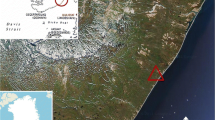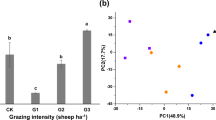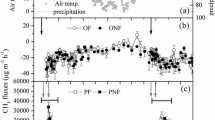Abstract
Purpose
Microbial oxidation by bacteria with the potential to oxidize C1 compounds (methanotrophs) is the only biological sink for atmospheric methane (CH4). Aerobic methanotrophs are particularly active in forest soils, but the role of aerobic methanotrophs in native forest soils in China remains poorly understood. The pmoA gene, encoding the key enzyme methane monooxygenase (particulate MMO), is widely used to identify methanotrophic communities.
Materials and methods
We collected soils from different vegetation types in one subtropical and one temperate forest in China. Potential CH4 oxidation rates and methanotroph communities were assessed via laboratory incubation and pmoA-based phylogenetic analysis, respectively.
Results and discussion
Across all sampling sites, we observed distinct variations in methanotroph community composition and CH4 oxidation rates. In all soils, CH4 oxidation rates increased with increasing CH4 concentration. Elevated temperature resulted in an increase in the CH4 oxidation rates in coniferous forests, while a decrease in deciduous forests. Restriction fragment length polymorphism analyses indicated that methantrophic community varied in different vegetation types. The methanotroph communities were dominated by type II methanotrophs (including soil cluster alpha (SCα), Methylocystis, and USCα) and type I methanotrophs (including USCγ and Methylobacter) in deciduous and coniferous forests, respectively.
Conclusions
It is suggested that intrinsic differences in CH4 oxidation rate responses to temperature between coniferous and deciduous soils are likely due to different methanotroph community structures. Taken together, the direction of CH4 feedback responses to disturbance was site specific.



Similar content being viewed by others
References
Angel R, Conrad R (2009) In situ measurement of methane fluxes and analysis of transcribed particulate methane monooxygenase in desert soils. Environ Microbiol 11:2598–2610
Bissett A, Abell GC, Bodrossy L, Richardson AE, Thrall PH (2012) Methanotrophic communities in Australian woodland soils of varying salinity. FEMS Microbiol Ecol 80:685–695
Bourne DG, McDonald IR, Murrell JC (2001) Comparison of pmoA PCR primer sets as tools for investigating methanotroph diversity in three Danish soils. Appl Environ Microbiol 67:3802–3809
Ciais P, Sabine C, Bala G, Bopp L, Brovkin V, Canadell J et al (2013) Carbon and other biogeochemical cycles. In: Stocker TF, Qin D, Plattner GK, Tignor M, Allen AK, Boschung J, Nauels A, Xia Y, Bex V, Midgley PM (eds) Climate change 2013: the physical science basis, Contribution of Working Group I to the Fifth Assessment Report of the Intergovernmental Panel on Climate Change. Cambridge University Press, Cambridge, pp 465–570
Costa KH, Groffman PM (2013) Factors regulating net methane flux by soils in urban forests and grasslands. Soil Sci Soc Am J 77:850–855
Costello AM, Lidstrom ME (1999) Molecular characterization of functional and phylogenetic genes from natural populations of methanotrophs in lake sediments. Appl Environ Microbiol 65:5066–5074
Dalal RC, Allen DE, Livesley SJ, Richards G (2008) Magnitude and biophysical regulators of methane emission and consumption in the Australian agricultural, forest, and submerged landscapes: a review. Plant Soil 309:43–76
Deng YC, Cui XY, Luke C, Dumont MG (2013) Aerobic methanotroph diversity in Riganqiao peatlands on the Qinghai-Tibetan Plateau. Environ Microbiol Rep 5:566–574
Di HJ, Cameron KC, Shen JP, Winefield CS, O’Callaghan M, Bowatte S, He JZ (2011) Methanotroph abundance not affected by applications of animal urine and a nitrification inhibitor, dicyandiamide, in six grazed grassland soils. J Soils Sediments 11:432–439
Dumont MG, Luke C, Deng YC, Frenzel P (2014) Classification of pmoA amplicon pyrosequences using BLAST and the lowest common ancestor method in MEGAN. Front Microbiol 5(34)
Dutaur L, Verchot LV (2007) A global inventory of the soil CH4 sink. Glob Biogeochem Cycles 21(4). https://doi.org/10.1029/2006GB002734
FAO (2010) Global forest resources assessment 2010: main report. Food and Agriculture Organization of the United Nations, Rome
Green JL, Bohannan BJM, Whitaker RJ (2008) Microbial biogeography: from taxonomy to traits. Science 320:1039–1043
Ho A, Kerckhof FM, Luke C, Reim A, Krause S, Boon N, Bodelier PLE (2013) Conceptualizing functional traits and ecological characteristics of methane-oxidizing bacteria as life strategies. Environ Microbiol Rep 5:335–345
Holmes AJ, Costello A, Lidstrom ME, Murrell JC (1995) Evidence that participate methane monooxygenase and ammonia monooxygenase may be evolutionarily related. FEMS Microbiol Lett 132:203–208
Hou W, Lian B, Rothenberg S (2010) Two electrophoreses in different pH buffers to purify forest soil DNA contaminated with humic substances. Afr J Biotechnol 9:2401–2407
Hutchens E, Radajewski S, Dumont MG, McDonald IR, Murrell IC (2004) Analysis of methanotrophic bacteria in Movile Cave by stable isotope probing. Environ Microbiol 6:111–120
IPCC (2013) Climate change 2013: the physical science basis. In: Contribution of Working Group I to the Fifth Assessment Report of the Intergovernmental Panel on Climate Change. Cambridge University Press, Cambridge
Kirschke S, Bousquet P, Ciais P, Saunois M, Canadell JG, Dlugokencky EJ et al (2013) Three decades of global methane sources and sinks. Nat Geosci 6:813–823
Knief C, Lipski A, Dunfield PE (2003) Diversity and activity of methanotrophic bacteria in different upland soils. Appl Environ Microbiol 69:6703–6714
Kolb S (2009) The quest for atmospheric methane oxidizers in forest soils. Environ Microbiol Rep 1:336–346
Kou Y, Li J, Wang Y, Li C, Tu B, Yao M, Li X (2017) Scale-dependent key drivers controlling methane oxidation potential in Chinese grassland soils. Soil Biol Biochem 111:104–114
Lau MCY, Stackhouse BT, Layton AC, Chauhan A, Vishnivetskaya TA, Chourey K, Ronholm J, Mykytczuk NCS, Bennett PC, Lamarche-Gagnon G, Burton N, Pollard WH, Omelon CR, Medvigy DM, Hettich RL, Pfiffner SM, Whyte LG, Onstott TC (2015) An active atmospheric methane sink in high Arctic mineral cryosols. ISME J 9:1880–1891
Levine UY, Teal TK, Robertson GP, Schmidt TM (2011) Agriculture’s impact on microbial diversity and associated fluxes of carbon dioxide and methane. ISME J 5:1683–1691
Lima AB, Muniz AW, Dumont MG (2014) Activity and abundance of methane-oxidizing bacteria in secondary forest and manioc plantations of Amazonian Dark Earth and their adjacent soils. Front Microbiol 5:550
Livesley SL, Kiese R, Miehle P, Weston CJ, Butterbach-Bahl K, Arndt SK (2009) Soil-atmosphere exchange of greenhouse gases in a Eucalyptus marginata woodland, a clover-grass pasture, and Pinus radiata and Eucalyptus globulus plantations. Glob Chang Biol 15:425–440
Luke C, Frenzel P (2011) Potential of pmoA amplicon pyrosequencing for methanotroph diversity studies. Appl Environ Microbiol 77:6305–6309
Malghani S, Reim A, von Fischer J, Conrad R, Kuebler K, Trumbore SE (2016) Soil methanotroph abundance and community composition are not influenced by substrate availability in laboratory incubations. Soil Biol Biochem 101:184–194
Martins CSC, Nazaries L, Macdonald CA, Anderson IC, Singh BK (2015) Water availability and abundance of microbial groups are key determinants of greenhouse gas fluxes in a dryland forest ecosystem. Soil Biol Biochem 86:5–16
Matheson CD, Gurney C, Esau N, Lehto R (2010) Assessing PCR inhibition from humic substances. Open Enzyme Inhib J 3:38–45
Maurer D, Kolb S, Haumaier L, Borken W (2008) Inhibition of atmospheric methane oxidation by monoterpenes in Norway spruce and European beech soils. Soil Biol Biochem 40:3014–3020
Mohanty SR, Bodelier PLE, Conrad R (2007) Effect of temperature on composition of the methanotrophic community in rice field and forest soil. FEMS Microbiol Ecol 62:24–31
Nazaries L, Tate KR, Ross DJ, Singh J, Dando J, Saggar S, Baggs EM, Millard P, Murrell JC, Singh BK (2011) Response of methanotrophic communities to afforestation and reforestation in New Zealand. ISME J 5:1832–1836
Noll M, Frenzel P, Conrad R (2008) Selective stimulation of type I methanotrophs in a rice paddy soil by urea fertilization revealed by RNA-based stable isotope probing. FEMS Microbiol Ecol 65:125–132
Praeg N, Wagner AO, Illmer P (2017) Plant species, temperature, and bedrock affect net methane flux out of grassland and forest soils. Plant Soil 410:193–206
Prescott CE, Grayston SJ (2013) Tree species influence on microbial communities in litter and soil: current knowledge and research needs. For Ecol Manag 309:19–27
Price SJ, Sherlock RR, Kelliher FM, McSeveny TM, Tate KM, Condron LM (2004) Pristine New Zealand forest soil is a strong methane sink. Glob Chang Biol 10:16–26
Qiu QF, Noll M, Abraham WR, Lu YH, Conrad R (2008) Applying stable isotope probing of phospholipid fatty acids and rRNA in a Chinese rice field to study activity and composition of the methanotrophic bacterial communities in situ. ISME J 2:602–614
Ridgwell AJ, Marshall SJ, Gregson K (1999) Consumption of atmospheric methane by soils: a process-based model. Glob Biogeochem Cycles 13:59–70
Shrestha PM, Kammann C, Lenhart K, Dam B, Liesack W (2012) Linking activity, composition and seasonal dynamics of atmospheric methane oxidizers in a meadow soil. ISME J 6:1115–1126
Singh BK, Tate KR, Ross DJ, Singh J, Dando J, Thomas N, Millard P, Murrell JC (2009) Soil methane oxidation and methanotroph responses to afforestation of pastures with Pinus radiata stands. Soil Biol Biochem 41:2196–2205
Smith KA, Dobbie KE, Ball BC, Bakken LR, Sitaula BK, Hansen S, Brumme R, Borken W, Christensen S, Prieme A, Fowler D, Macdonald JA, Skiba U, Klemedtsson L, Kasimir-Klemedtsson A, Degorska A, Orlanski P (2000) Oxidation of atmospheric methane in Northern European soils, comparison with other ecosystems, and uncertainties in the global terrestrial sink. Glob Chang Biol 6:791–803
Tate KR (2015) Soil methane oxidation and land-use change—from process to mitigation. Soil Biol Biochem 80:260–272
Tate KR, Walcroft AS, Pratt C (2012) Varying atmospheric methane concentrations affect soil methane oxidation rates and methanotroph populations in pasture, an adjacent pine forest, and a landfill. Soil Biol Biochem 52:75–81
Tietze W, Domrös M (1987) The climate of China. GeoJournal 14:265–266
Urbanova M, Snajdr J, Baldrian P (2015) Composition of fungal and bacterial communities in forest litter and soil is largely determined by dominant trees. Soil Biol Biochem 84:53–64
Wang YF, Chen H, Zhu Q, Peng C, Wu N, Yang G, Zhu D, Tian JQ, Tian LX et al (2014) Soil methane uptake by grasslands and forests in China. Soil Biol Biochem 74:70–81
Yan JH, Zhang W, Wang KY, Qin F, Wang WT, Dai HT, Li PX (2014) Responses of CO2, N2O and CH4 fluxes between atmosphere and forest soil to changes in multiple environmental conditions. Glob Chang Biol 20:300–312
Yang JQ, Tang WQ, Liao TY, Sun Y, Zhou ZC, Han CC, Liu D, Lin HD (2012) Phylogeographical analysis on Squalidus argentatus recapitulates historical landscapes and drainage evolution on the island of Taiwan and Mainland China. Int J Mol Sci 13:1405–1425
Zhang YG, Cong J, Lu H, Yang CY, Yang YF, Zhou JH, Li DQ (2014) An integrated study to analyze soil microbial community structure and metabolic potential in two forest types. PLoS One 9. https://doi.org/10.1371/journal.pone.0093773
Zhang JJ, Peng CH, Zhu QA, Xue W, Shen Y, Yang YZ, Shi GH, Shi SW, Wang M (2016) Temperature sensitivity of soil carbon dioxide and nitrous oxide emissions in mountain forest and meadow ecosystems in China. Atmos Environ 142:340–350
Zheng Y, Zhang LM, He JZ (2013) Immediate effects of nitrogen, phosphorus, and potassium amendments on the methanotrophic activity and abundance in a Chinese paddy soil under short-term incubation experiment. J Soils Sediments 13:189–196
Acknowledgements
The authors give special thanks to Mr. Gang Yang, YiXin He, Wei Xue, Zhijun Qiu, Dan Zhu, Wenqiang Hu, ZhenZhi Bai, and Ms. JunJun Zhang for their help in sample collection and to Ms. Dan Xue, QiuPing Zhong, XinYa Huang, Wei Li, and LiFan Xiao for some soil chemical characteristics tests.
Funding
This work was supported by the National Key R&D Program of China (Grant No. 2016YFC0501804), the 1000 Talents Program of Sichuan Province of China, and the Youth Science and Technological Innovation Team Program, Sichuan Province (Grant No. 2015TD0026).
Author information
Authors and Affiliations
Corresponding authors
Additional information
Responsible editor: Weixin Ding
Electronic supplementary material
ESM 1
(DOCX 134 kb)
Rights and permissions
About this article
Cite this article
Zeng, L., Tian, J., Chen, H. et al. Changes in methane oxidation ability and methanotrophic community composition across different climatic zones. J Soils Sediments 19, 533–543 (2019). https://doi.org/10.1007/s11368-018-2069-1
Received:
Accepted:
Published:
Issue Date:
DOI: https://doi.org/10.1007/s11368-018-2069-1




